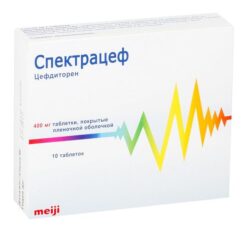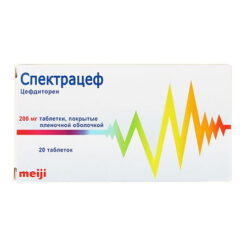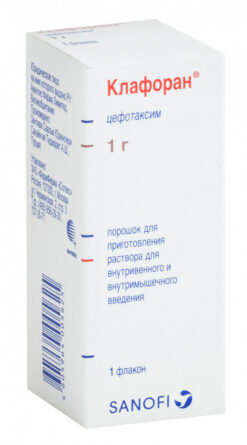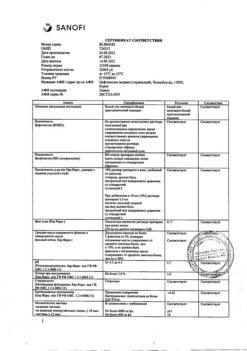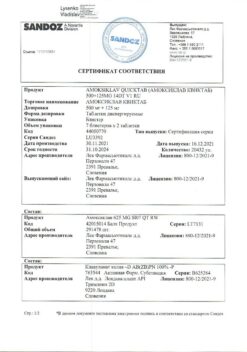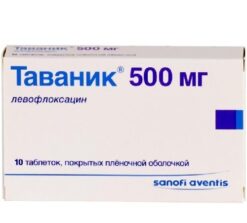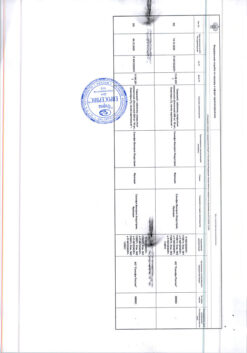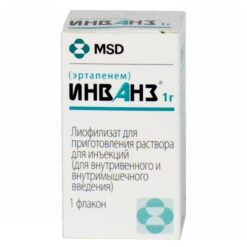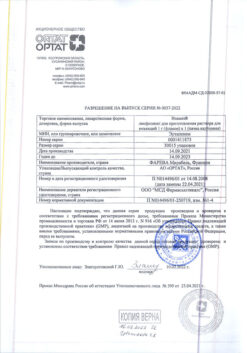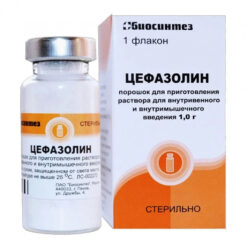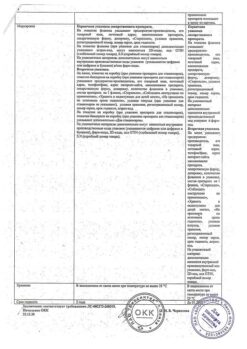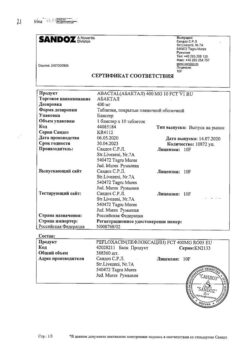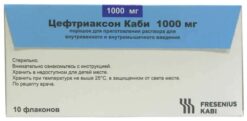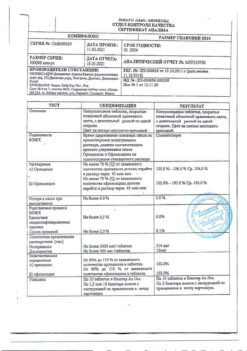No products in the cart.
Spectraceph, 200 mg 14 pcs
€26.95 €23.35
Out of stock
(E-mail when Stock is available)
Description
Pharmacological action – antibacterial.
Pharmacodynamics
The mechanism of action. Cefditorena pivaxil is a semi-synthetic beta-lactam antibiotic, is a prodrug of cefditorena (third generation cephalosporin). The mechanism of action of the drug is associated with inhibition of bacterial wall synthesis due to its affinity to penicillin-binding proteins.
Pharmacokinetic/pharmacodynamic characteristics. When the drug is administered at a dose of 200 mg 2 times daily, its plasma concentration exceeds the minimum suppressive concentration against 90% of microorganisms (MPK90) for Moraxella catarrhalis, Haemophilus influenzae, Haemophilus parainfluenzae, Streptococcus pyogenes and penicillin-sensitive strains of Streptococcus pneumoniae for at least 50% of the dosing interval. Administration of cefditorin at a dose of 400 mg twice daily maintains its concentration above the minimum suppressive concentration (MSC) for 51% of the dosing interval, which exceeds the minimum suppressive concentration against 50% of microorganisms (MSC50) for penicillin-resistant Streptococcus pneumoniae.
The mechanisms of resistance. Cefditorin as a third-generation cephalosporin has common resistance mechanisms for this group of antibiotics. Resistance of gram-positive microorganisms may be associated with a change in the penicillin-binding protein of Streptococcus pneumoniae and Streptococcus viridans, or the appearance of an additional penicillin-binding protein (PBP2a) in Staphylococcus spp. Cefditorin is resistant to most of the most common chromosomal and plasmid beta-lactamases of Gram-negative bacteria. At the same time, like other cephalosporins, cefditorin is hydrolyzed by broad-spectrum plasmid-mediated beta-lactamases. In addition, the production of chromosomal beta-lactamase in mutant strains of Enterobacter spp., Citrobacter spp., Morganella spp. and Serratia spp.
The mechanism of action of cefditorin is similar to other cephalosporin antibiotics and differs from the mechanism of action of other groups of antibiotics. In general, no cross-resistance between cefditorene and other groups of antibiotics has been noted. However, in rare cases, certain mechanisms of action (e.g., related to the impermeability of the inner membrane or the presence of a mechanism for active removal of the antibiotic from the cell) may be similar for all antibiotic groups. This accounts for a certain level of resistance to all antibiotics.
The MPC. The recommended MAC values for cefditorin to classify microorganisms with high, intermediate sensitivity and resistance are: sensitive ≤0.5 µg/mL, intermediate sensitivity, >0.5 and < 2 µg/mL, resistant ≥2 µg/mL.
Sensitivity. Table 1 below outlines the sensitivity spectrum of most microorganisms for approved indications. The prevalence of acquired resistance may vary by geographic area as well as in individual pathogens. For this reason, it is desirable to obtain information on the sensitivity of microorganisms in a particular region, especially when treating severe infections. In cases where pathogen resistance is questionable, the assistance of a specialist may be sought to evaluate the appropriateness of prescribing ceftiditorin in a particular clinical setting.
Table 1
Sensitivity spectrum for most microorganisms for approved indications
| Generally sensitive species (resistance less than 10%, European data) |
| Aerobic gram-positive microorganisms: |
| Group C and G Streptococci |
| Methicillin-sensitive strains: |
| Staphylococcus aureus1 | Streptococcus agalactiae |
| Streptococcus pneumoniae Streptococcus pneumoniae1, 2 |
| Streptococcus pyogenes1 |
| Aerobic Gram-negative microorganisms: |
| Haemophilus influenzae1 |
| Moraxella catarrhalis1 |
| Anaerobic microorganisms: |
| Clostridium perfringes |
| Peptostreptococcus spp. |
| Microorganisms with initial resistance to ceftiditorin: |
| Aerobic Gram-positive microorganisms: |
| Enterococcus spp. |
| Methicillin-resistant strains of Staphylococcus aureus |
| Aerobic Gram-negative microorganisms: |
| Acipetobacter baumanii |
| Pseudomonas aeruginosa |
| Anaerobic microorganisms: |
| Bacteroides fragilis group | Clostridium difficile |
| Others: |
| Chlamydia spp. |
| Mycoplasma spp. |
| Legionella spp. |
1Clinical efficacy has been shown for sensitive pathogens for approved indications.
2Some strains with high penicillin resistance may have reduced sensitivity to ceftiditorin. Strains resistant to cefotaxime and ceftriaxone should not be considered sensitive to ceftiditorin. Gram-negative microorganisms that contain chromosomal beta-lactamases, such as Citrobacter freundii, Enterobacter aerogenes, Enterobacter cloacae, Morganella morganii, Serratia marcescens, should be considered resistant to ceftiditorin despite their apparent susceptibility in vitro.
Pharmacokinetics
Intake. After oral administration of cefditoren pivoxil, it is absorbed in the gastrointestinal tract and is hydrolyzed to cefditoren under the action of esterases. Oral administration of 200 mg of the drug after a meal is accompanied by reaching a maximum concentration (Cmax) of 2.6 mcg/ml in about 2.5 hours, while 400 mg of the drug leads to reaching Cmax of 4.1 mcg/ml after the same period. The absolute bioavailability of ceftiditorin after oral administration compared to intravenous administration is approximately 15-20%.
The presence of food in the gastrointestinal tract accelerates absorption of ceftiditoren pivoxil that leads to increase of Cmax and area under the pharmacokinetic curve “concentration – time” (AUC) by 50 and 70% compared to values on an empty stomach, respectively.
Binding to plasma proteins and distribution. Binding of ceftiditorin to plasma proteins is 88%. Pharmacokinetic parameters did not differ after multiple and single drug administration; this indicates the absence of cumulation. The volume of distribution of ceftiditorin at equilibrium concentration does not differ significantly from this indicator calculated after single administration; it practically does not depend on the administered dose and always remains within 40-65 l.
After a single injection of 400 mg of the drug penetration into the mucous membrane and bronchial secretion was 60 and 20% of the blood plasma concentration, respectively. The results of administration of a similar dose to healthy volunteers and subsequent evaluation of penetration of the antibiotic into interstitial fluid showed that after 8 and 12 hours the concentration of ceftiditorin in interstitial fluid reached 40 and 56% of the plasma area under the pharmacokinetic curve, respectively.
Metabolism/excretion. Regardless of the dose and duration of treatment, up to 18% of the administered dose of ceftiditorin is excreted unchanged by the kidneys. Half-life of the drug from plasma is about 1.0-1.5 hours. Total clearance with correction for bioavailability is about 25-30 l/h, renal clearance is about 80-90 ml/min. Studies of labeled ceftiditorin in healthy volunteers have shown that unabsorbed part of the drug is excreted through the intestine, and most of the cefditorin is converted into inactive metabolites – P7 and M-ON. During hydrolysis of pivoxil cefditoren, pivalate is formed, which is excreted by the kidneys as pivaloylcarnitine conjugate.
Particular patient groups
Paul. The pharmacokinetics of cefditorin pivoxil have no significant differences in humans according to gender.
Elderly patients. When administered with the same doses, cefditorin concentrations are slightly higher in elderly patients (aged over 65 years) compared to the middle-aged adult population; Cmax and AUC values are about 26% and 33% higher in these patients, respectively. Except in cases of severe renal and/or hepatic impairment, elderly patients do not require dose adjustment.
Renal dysfunction. After repeated administration of cefditorin pivoxil at a dose of 400 mg, AUC values in healthy volunteers and patients with kidney damage of various degrees of severity.
The observed changes in pharmacokinetic parameters of ceftiditorin in patients with mild renal impairment are not considered to be clinically significant. In patients with moderate to severe renal impairment the AUC is approximately 3 times higher compared to healthy volunteers. The currently available data do not allow recommending any doses of the drug to patients on hemodialysis.
Liver dysfunction. The effect of mild to moderate hepatic dysfunction on the pharmacokinetics of ceftiditorin pivoxil after its administration at a dose of 400 mg includes a slight increase in the main pharmacokinetic parameters without statistically significant differences. In addition, there was a slight increase in the amount of the drug excreted by the kidneys compared to healthy volunteers. Similar data in patients with severe hepatic impairment have not been obtained to date.
Indications
Indications
Treatment of infections caused by microorganisms sensitive to cefditoren:
upper respiratory tract infections: acute tonsillopharyngitis, acute sinusitis;
lower respiratory tract infections: exacerbation of chronic bronchitis, community-acquired pneumonia;
uncomplicated infections of the skin and subcutaneous fat: cellulitis, infected skin wounds, abscess, folliculitis, impetigo and furunculosis.
Pharmacological effect
Pharmacological effect
Pharmacological action – antibacterial.
Pharmacodynamics
Mechanism of action. Cefditoren pivoxil is a semisynthetic beta-lactam antibiotic, a prodrug of cefditoren (a third-generation cephalosporin). The mechanism of action of the drug is associated with inhibition of bacterial wall synthesis due to its affinity for penicillin-binding proteins.
Pharmacokinetic/pharmacodynamic features. When the drug is prescribed at a dose of 200 mg 2 times a day, its plasma concentration exceeds the minimum inhibitory concentration for 90% of microorganisms (MIC90) for Moraxella catarrhalis, Haemophilus influenzae, Haemophilus parainfluenzae, Streptococcus pyogenes and penicillin-sensitive strains of Streptococcus pneumoniae for at least 50% of the time of the dosing interval. Administration of cefditorene at a dose of 400 mg twice daily ensures that its concentration is maintained above the minimum inhibitory concentration (MIC) for 51% of the dosing interval, which exceeds the minimum inhibitory concentration against 50% of microorganisms (MIC50) for penicillin-resistant Streptococcus pneumoniae.
Mechanisms of resistance. Cefditoren, as a third generation cephalosporin, has common resistance mechanisms for this group of antibiotics. Resistance of gram-positive microorganisms may be associated with changes in the penicillin-binding protein of Streptococcus pneumoniae and Streptococcus viridans, or the appearance of an additional penicillin-binding protein (PBP2a) in Staphylococcus spp. Cefditoren is resistant to most of the most common chromosomal and plasmid beta-lactamases of gram-negative bacteria. However, like other cephalosporins, cefditoren is hydrolyzed by broad-spectrum beta-lactamases mediated by plasmids. In addition, the cause of resistance may be the production of chromosomal beta-lactamase in mutant strains of Enterobacter spp., Citrobacter spp., Morganella spp. and Serratia spp.
The mechanism of action of cefditoren is similar to other cephalosporin antibiotics and differs from the mechanism of action of other groups of antibiotics. In general, no cross-resistance was observed between cefditoren and other groups of antibiotics. However, in rare cases, some mechanisms of action (for example, those associated with the impermeability of the inner membrane or the presence of a mechanism for active removal of the antibiotic from the cell) may be similar for all groups of antibiotics. This causes a certain level of resistance to all antibiotics.
IPC. Recommended MIC values for cefditoren, allowing to classify microorganisms with high, intermediate sensitivity and resistance: sensitive ≤0.5 µg/ml, with intermediate sensitivity – >0.5 and <2 µg/ml, resistant - ≥2 µg/ml.
Sensitivity. Table 1 below provides information on the sensitivity spectrum of most microorganisms for approved indications. The prevalence of acquired resistance may vary depending on the geographical area and also among individual pathogens. For this reason, it is desirable to obtain information about the susceptibility of microorganisms in a particular region, especially when treating a severe infection. In cases where the resistance of pathogens is in doubt, you can seek help from a specialist who will assess the advisability of prescribing cefditoren in a specific clinical case.
Table 1
Sensitivity spectrum of most microorganisms for approved indications
Usually susceptible species (less than 10% resistance, European data)
Aerobic gram-positive microorganisms:
Streptococci groups C and G
Strains sensitive to methicillin:
Staphylococcus aureus1
Streptococcus agalactiae
Streptococcus pneumoniae1, 2
Streptococcus pyogenes1
Aerobic gram-negative microorganisms:
Haemophilus influenzae1
Moraxella catarrhalis1
Anaerobic microorganisms:
Clostridium perfringes
Peptostreptococcus spp.
Microorganisms with initial resistance to cefditoren:
Aerobic gram-positive microorganisms:
Enterococcus spp.
Methicillin-resistant strains of Staphylococcus aureus
Aerobic gram-negative microorganisms:
Acinetobuster baumanii
Pseudomonas aeruginosa
Anaerobic microorganisms:
Bacteroides fragilis group
Clostridium difficile
Other:
Chlamydia spp.
Mycoplasma spp.
Legionella spp.
1Clinical efficacy has been demonstrated for susceptible pathogens in approved indications.
2Some strains with high resistance to penicillin may have reduced sensitivity to cefditoren. Strains resistant to cefotaxime and ceftriaxone should not be considered susceptible to cefditoren. Gram-negative microorganisms that contain chromosomal beta-lactamases, such as Citrobacter freundii, Enterobacter aerogenes, Enterobacter cloacae, Morganella morganii, Serratia marcescens, should be considered resistant to cefditoren, despite their apparent susceptibility in vitro.
Pharmacokinetics
Suction. After oral administration of cefditoren pivoxil, it is absorbed from the gastrointestinal tract and hydrolyzed to cefditoren by the action of esterases. Oral administration of 200 mg of the drug after food is accompanied by the achievement of a maximum concentration (Cmax) of 2.6 μg/ml after approximately 2.5 hours, while administration of 400 mg of the drug leads to a Cmax of 4.1 μg/ml after the same period of time. The absolute bioavailability of cefditoren after oral administration compared to intravenous administration is about 15–20%.
The presence of food in the gastrointestinal tract accelerates the absorption of cefditorene pivoxil, resulting in an increase in Cmax and area under the concentration-time curve (AUC) by 50 and 70% compared to fasting values, respectively.
Plasma protein binding and distribution. The binding of cefditoren to plasma proteins is 88%. After repeated and single doses of the drug, the pharmacokinetic parameters did not differ; this indicates the absence of cumulation. The volume of distribution of cefditoren under conditions of equilibrium concentration does not differ significantly from this indicator calculated after a single administration; it is practically independent of the administered dose and always remains within the range of 40–65 l.
After a single injection of 400 mg of the drug, penetration into the mucous membrane and bronchial secretions was 60 and 20% of the concentration in the blood plasma, respectively. The results of administering a similar dose to healthy volunteers and subsequent assessment of the penetration of the antibiotic into the interstitial fluid showed that after 8 and 12 hours, the concentration of cefditoren in the interstitial fluid reached 40 and 56% of the plasma area under the pharmacokinetic curve, respectively.
Metabolism/excretion. Regardless of the dose and duration of treatment, up to 18% of the administered dose of cefditoren is excreted unchanged by the kidneys. The half-life of the drug from plasma is about 1.0–1.5 hours. Total clearance adjusted for bioavailability is about 25–30 l/h, renal clearance is about 80–90 ml/min. Studies of labeled cefditoren in healthy volunteers showed that the unabsorbed portion of the drug is excreted through the intestine, and a larger proportion of cefditoren is converted into inactive metabolites – P7 and M-OH. During the hydrolysis of cefditorene pivoxil, pivalate is formed, which is excreted by the kidneys in the form of pivaloylcarnitine conjugate.
Special patient groups
Floor. The pharmacokinetics of cefditoren pivoxil does not differ significantly in humans depending on gender.
Elderly patients. At the same dose, the concentration of cefditorene in elderly patients (over 65 years of age) is slightly higher compared to the population of middle-aged adults; Cmax and AUC rates in such patients are approximately 26 and 33% higher, respectively. Except in cases of severe renal and/or hepatic insufficiency, no dosage adjustment is required in elderly patients.
Renal dysfunction. After repeated administration of cefditoren pivoxil at a dose of 400 mg, AUC values in healthy volunteers and patients with varying degrees of renal impairment.
The observed changes in the pharmacokinetic parameters of cefditoren in patients with mild renal impairment are not considered clinically significant. In patients with moderate to severe renal impairment, the AUC is approximately 3 times higher compared to healthy volunteers. Currently available data do not allow us to recommend any doses of the drug for patients on hemodialysis.
Liver dysfunction. The effect of mild to moderate hepatic impairment on the pharmacokinetics of cefditoren pivoxil after administration at a dose of 400 mg includes a slight increase in the main pharmacokinetic parameters without statistically significant differences. In addition, there was a slight increase in the amount of drug excreted by the kidneys compared to healthy volunteers. Similar data have not been obtained to date in patients with severe liver failure.
Special instructions
Special instructions
Before prescribing Spectracef, the patient’s medical history should be carefully ascertained for the presence of allergic reactions. If a hypersensitivity reaction develops, treatment should be discontinued and the patient prescribed the necessary treatment.
Elderly patients. The incidence of adverse reactions in elderly patients does not differ from that in the general population. However, caution should be exercised when prescribing Spectracef due to reduced physiological functions in the elderly, and it is recommended to adjust the dose and intervals according to the current condition of the patients. Thus, there was a delay in the elimination of the drug in patients with impaired renal function, the concentration of the drug in the blood was increased. It has also been reported that elderly people are prone to bleeding due to vitamin K deficiency after using cephalosporin drugs.
As with other broad-spectrum antibiotics, treatment with cefditoren may lead to an overgrowth of resistant microflora. For this reason, monitoring of patients receiving this drug is recommended, especially in case of long-term treatment.
In patients with severe renal impairment, periodic monitoring of renal function is recommended.
During the course of treatment with cephalosporins, a decrease in prothrombin activity is possible. For this reason, in patients at risk (with renal or hepatic insufficiency or in the case of previous prescription of anticoagulants), monitoring of prothrombin time is necessary.
The development of diarrhea during or after treatment, especially if it is severe, persistent and contains blood, may indicate pseudomembranous colitis. In mild cases of diarrhea, simply discontinuing the drug is sufficient; in more severe cases, antibiotic therapy, to which Clostridium difficile is sensitive, and infusion therapy are indicated.
Like other cephalosporins, cefditoren may cause a false-positive result from the direct Coombs test, the detection of glucose in urine by the copper reduction test, but not by the enzyme test.
Due to the high risk of a false-negative result of the ferricyanide test for determining plasma or blood glucose, it is recommended that during treatment with cefditoren, glucose oxidase or glucose hexokinase methods are used to determine the concentration of glucose in the blood or plasma of patients.
When cephalosporins are combined with aminoglycosides and/or loop diuretics, especially in patients with impaired renal function, the risk of nephrotoxicity may increase.
Spectracef contains approximately 13.1 mg (for 200 mg tablets) and 26.2 mg (for 400 mg tablets) sodium per dose, which should be considered when prescribing the drug to patients on a low-sodium diet.
A decrease in serum carnitine has been reported as a consequence of the metabolism of pivalic acid (a metabolite of drugs in the pivoxil group) when taking drugs containing pivoxil.
Impact on the ability to drive a car and/or other mechanisms. The effect of cefditorene pivoxil on the ability to drive a car and/or use other machines has not been reported. At the same time, it should be borne in mind that taking Spectracef may be accompanied by undesirable effects such as vomiting and headache.
Active ingredient
Active ingredient
Cefditoren
Composition
Composition
1 Film-coated tablet:
Active ingredient:
cefditoren pivoxil (in terms of cefditoren) – 200.00 mg,
Excipients: mannitol as needed (approximately 35 mg), sodium caseinate 100 mg, croscarmellose sodium 150 mg, sodium tripolyphosphate 4 mg, magnesium stearate 5 mg, Opadry white 35 mg (hypromellose 21.9 mg, titanium dioxide 10.9 mg, macrogol-400 2.2 mg), carnauba wax 0.06 mg, Opacode blue ink (shellac IN IMS 74 OP, FD&C blue No. 1 50.41%, butanol 24.35%, aluminum varnish based on brilliant blue dye 11.25%, titanium dioxide 4.49%, propylene glycol 2.91%, isopropanol 4.65%, concentrated ammonia solution 1.94%).
Pregnancy
Pregnancy
Pregnancy. Clinical data on the use of cefditoren pivoxil in pregnant women have not been obtained. Although animal studies have not shown embryotoxic or teratogenic effects of the drug, Spectracef should not be used during pregnancy unless the expected benefit to the mother outweighs the potential risk to the fetus. Cases of hypocarnitinemia have also been reported in both women receiving antimicrobial agents containing pivoxil and their newborns.
Lactation period. There is insufficient data on the penetration of cefditoren into breast milk. Therefore, breastfeeding should be discontinued when using Spectracef.
Contraindications
Contraindications
hypersensitivity to cefditoren, other cephalosporins or any other component of the drug;
severe allergic reactions to penicillins and other beta-lactam antibacterial drugs;
Child-Pugh class C liver failure;
patients on hemodialysis;
history of hypersensitivity reactions to casein protein;
primary carnitine deficiency;
simultaneous use of cefditoren pivoxil and H2-histamine receptor blockers;
children’s age up to 12 years.
With caution: patients with hypersensitivity to other beta-lactam antibiotics due to the possibility of developing cross-allergic reactions; patients with an individual or family/hereditary predisposition to the development of allergic reactions such as bronchial asthma, rash or urticaria; patients with severe renal impairment (see “Pharmacokinetics”); elderly patients (see “Special instructions”); simultaneous use with aminoglycosides and diuretics (furosemide); patients with gastrointestinal pathology, incl. history of colitis; patients with difficulty eating (swallowing problems) or receiving parenteral nutrition, as well as patients with poor general health (such patients should be closely monitored due to the risk of potassium deficiency).
Side Effects
Side Effects
The adverse events presented below are listed depending on the anatomical and physiological classification and frequency of occurrence. The frequency of occurrence is determined as follows: very often – ≥1/10; often – ≥1/100 and <1/10; uncommon - ≥1/1000 and <1/100; rarely - ≥1/10000 and <1/1000; very rarely - <1/10000, including isolated cases.
From the blood and lymphatic system: infrequently – eosinophilia; rarely – granulocytopenia, hemolytic anemia, agranulocytosis, hypoprothrombinemia, bleeding tendency, enlarged lymph nodes.
From the side of blood vessels: rarely – shock.
From the gastrointestinal tract: often – diarrhea; infrequently – softening of the stool, dyspepsia, discomfort in the abdomen, abdominal pain; rarely – pseudomembranous colitis, a feeling of abdominal enlargement, nausea, vomiting, stomatitis, glossitis.
General disorders and disorders at the injection site: rarely – swelling, fever.
From the liver and biliary tract: rarely – jaundice, impaired liver function.
From the immune system: rarely – anaphylaxis.
Infectious and parasitic diseases: rarely – candidiasis.
Laboratory and instrumental data: uncommon – increased alanine aminotransferase (ALT) activity, increased aspartate aminotransferase (AST) activity; rarely – thrombocytopenia, increased serum creatinine concentration, increased blood urea nitrogen concentration, increased alkaline phosphatase (ALP) activity; frequency unknown – decreased level of carnitine concentration in the blood serum.
Metabolism and nutrition: rarely – anorexia, symptoms due to vitamin K deficiency, symptoms due to deficiency of B vitamins.
From the musculoskeletal system and connective tissue: rarely – arthralgia.
From the nervous system: rarely – headache, neuritis, dizziness, numbness.
From the kidneys and urinary tract: rarely – acute renal failure, proteinuria.
From the respiratory system, chest and mediastinal organs: rarely – interstitial pneumonia, pulmonary eosinophilic infiltrate.
From the skin and subcutaneous tissues: infrequently – rash; rarely – Stevens-Johnson syndrome, toxic epidermal necrolysis (Lyell’s syndrome), urticaria, erythema, itching.
Interaction
Interaction
Antacids
The combined use of cefditoren pivoxil and antacids containing magnesium and aluminum hydroxide after meals reduces the Cmax and AUC of cefditoren by 14% and 11%, respectively. Although the clinical significance of this fact is unknown, it is recommended that the period between the administration of antacids and cefditoren pivoxil be 2 hours.
Probenecid
Co-administration of probenecid and cefditoren pivoxil reduces renal excretion of the antibiotic, increasing Cmax by 49%, AUC by 122%, and increasing the half-life of cefditoren by 53%.
H2-histamine receptor blockers
Concomitant administration of famotidine intravenously and cefditorene pivoxil orally leads to a decrease in Cmax and AUC by 27% and 22%, respectively. Thus, the simultaneous use of cefditoren pivoxil and H2-histamine receptor blockers is not recommended.
Overdose
Overdose
Symptoms: nausea, vomiting, diarrhea.
Treatment: symptomatic therapy.
Storage conditions
Storage conditions
In original packaging at a temperature not exceeding 30°C. Keep out of the reach of children.
Manufacturer
Manufacturer
Tedek Meigi Pharma S.A., Spain
Additional information
| Conditions of storage | In the original package at a temperature not exceeding 30°C. Keep out of reach of children. |
|---|---|
| Manufacturer | Tedek Meiji Pharma S.A., Spain |
| Medication form | pills |
| Brand | Tedek Meiji Pharma S.A. |
Other forms…
Related products
Buy Spectraceph, 200 mg 14 pcs with delivery to USA, UK, Europe and over 120 other countries.


